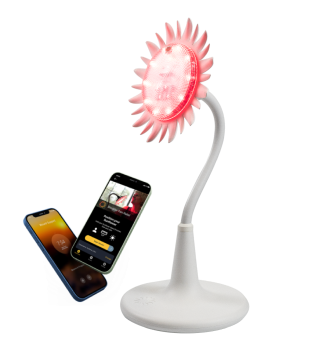
- Shop
- Learn
-
-
- Buy The Sunflower Now
Feel the difference
Get Started with JustLight
Sunflower is the most advanced light therapy available today.

-
- Collaborate
- Blog
- Quiz
- My Account
Free Shipping in the 48 States!
We will explore the types of UVB phototherapy, methods of treatment, and important considerations for prescribing and managing home phototherapy.
Buy Sunflower TodayPhototherapy, the use of light to treat medical conditions, has become an essential tool in dermatology. Among the various forms of phototherapy, ultraviolet light therapy (UVB) is a leading treatment for skin conditions such as psoriasis, eczema, and vitiligo. With advancements in technology, patients now have the option to undergo home UV light therapy, making treatment more convenient and accessible. In this article, we will explore the types of UVB phototherapy, methods of treatment, and important considerations for prescribing and managing home phototherapy.
Phototherapy uses specific wavelengths of light to target skin cells and reduce inflammation or overproduction of cells. The two main types of ultraviolet light used in phototherapy are UVA and UVB. In home treatment settings, UVB phototherapy is typically the preferred option due to its safety and efficacy.
UVB phototherapy is the most common form of light therapy used to treat various skin conditions. It involves exposing the skin to ultraviolet B light, which reduces inflammation and slows the rapid growth of skin cells that cause conditions like psoriasis. UVB phototherapy can be broken down into two primary types:
There are several ways to administer UVB phototherapy, depending on the area and severity of the skin condition. Here are the most common methods:
Localized phototherapy units are small devices designed to treat specific areas of the body. These are ideal for conditions that affect smaller patches of skin, such as localized psoriasis or eczema. These devices are typically handheld and can be used to target areas like the scalp, face, or elbows.
An excimer laser is a specialized tool that delivers high doses of narrowband UVB light to specific areas of the skin. This method is particularly effective for hard-to-treat areas or for patients who have not responded well to traditional UVB phototherapy. While highly effective, excimer laser treatments are usually performed in a clinical setting rather than at home.
The advent of home phototherapy units has transformed the treatment landscape for patients with chronic skin conditions. These units allow individuals to undergo UVB phototherapy from the comfort of their own home, eliminating the need for frequent visits to a phototherapy clinic. Home treatments are especially beneficial for those with mobility issues, time constraints, or who live far from a dermatology clinic.
Home UV light therapy is not suitable for everyone. Dermatologists must carefully evaluate each patient before prescribing home treatment. Some key considerations include:
Selecting the right candidates for home phototherapy involves assessing the patient’s ability to handle the equipment and follow the treatment schedule responsibly. Dermatologists typically recommend home therapy for patients who:
Home phototherapy equipment is designed to be user-friendly, with safety features such as automatic timers, eye protection, and adjustable light intensity. These devices are smaller than clinical units but still deliver effective doses of narrowband UVB light. Phototherapy units vary in size and functionality, from handheld devices for localized treatments to full-body units for patients with widespread skin conditions.
Before starting home phototherapy, patients must be properly educated about the equipment and the treatment process. Orientation typically includes:
Home phototherapy treatments require careful adherence to the prescribed protocol. This includes:
Home UV light therapy offers an effective, convenient, and safe option for patients with chronic skin conditions. By using narrowband UVB phototherapy, individuals can manage their condition from home while reducing the need for frequent clinic visits. With proper patient education, adherence to treatment protocols, and regular follow-up with a healthcare provider, home-based phototherapy like Sunflower can be a long-term solution for improving skin health.
Yes, UV light therapy can be done at home with devices like the Sunflower by JustLight. The Sunflower is a non-UV-based red and near-infrared light therapy device designed for safe, effective use at home. While traditional UV therapy is used for skin conditions, red light therapy is popular for reducing inflammation, improving skin health, and supporting muscle recovery, making it a versatile option for home treatment.
UV light therapy is an effective treatment for various skin conditions such as psoriasis, eczema, and vitiligo. It works by slowing the rapid growth of skin cells, reducing inflammation, and alleviating symptoms. However, the Sunflower by JustLight focuses on red and near-infrared light therapy, which offers benefits for skin rejuvenation, collagen production, and pain relief without the risks associated with UV exposure.
While it is possible to install UV lights in your home, they should be used with caution. For therapeutic purposes, devices like the Sunflower that utilize red and near-infrared light are safer alternatives to UV light. These therapies deliver similar benefits without the risk of skin damage, burns, or skin cancer that can result from improper UV exposure.
Yes, UVB lamps are effective for treating skin conditions at home under the guidance of a healthcare provider. However, the Sunflower by JustLight uses non-UV red light therapy, which offers anti-inflammatory and healing benefits without the potential side effects associated with UVB lamps. It is a safer, more versatile option for home use.
Yes, red light therapy is generally safer than UV light therapy for home use. Devices like the Sunflower by JustLight use red and near-infrared light, which provide a range of benefits such as improving skin health, reducing inflammation, and promoting cellular repair without the risks of UV exposure, such as skin damage or skin cancer. Red light therapy is non-invasive and has fewer potential side effects, making it a preferred choice for home treatment.